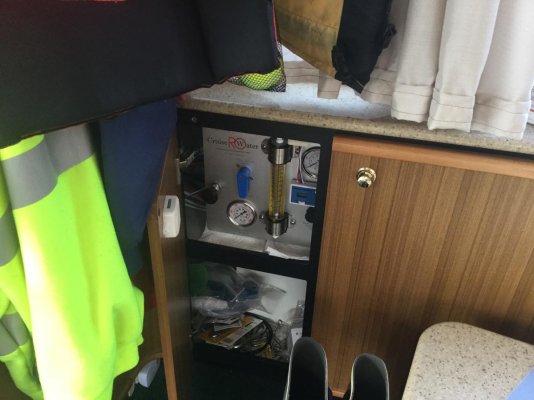Maerin
Guru
Typically, the VMT remote panel will start the boost pump (low pressure seawater feed pump) first. If it proves flow, then the HP pump will kick in. Using the remote precludes changing the backpressure, there's no facility to accomplish that from the remote panel. The typical use is in repeatable conditions so there's not a need to adjust the pressure every run. The remote is a convenience item.
The HP pump is probably a 3 cylinder, 1-1/2 HP pump with a centrifugal start switch and capacitor, 115/230 field convertable. I'm not sure how a soft start kit can be adapted to that configuration, you'll need to get the input from a motor expert for that. The pressure can indeed be set to bypass to startup, so the HP pump is starting with minimal load. It takes a couple of seconds to build backpressure even if the bypass valve is closed, so I'm not sure just how much difference that will make in inrush/start current. You'll just have to experiment and draw conclusions from real time factors. I'm also in the group that thinks a handoff from genset to inverter is possible.
My system is configured with an auto/off/manual switch that runs the HP pump, it bypasses a lockout that is triggered from the sensor unit that reads the TDS PPM content of the product water to shut down the pump if the TDS climbs over the setpoint (550 PPM). Point being, I can switch that bypass into "Auto" while the pump's running, it interrupts power to the pump for a split second, and the pump stays running. This is probably the same pump used in the STW600. My NF450 is just a basic (No Frills) version with a smaller membrane and no automated controls, although mine's wired 240V. So I'm out of the running for an inverter handoff.
I often wish I COULD run it underway, it'd be very convenient to arrive with a full tank of water. No genset running at anchor to make water. I'm with you 100% on that objective.
Good Luck!
The HP pump is probably a 3 cylinder, 1-1/2 HP pump with a centrifugal start switch and capacitor, 115/230 field convertable. I'm not sure how a soft start kit can be adapted to that configuration, you'll need to get the input from a motor expert for that. The pressure can indeed be set to bypass to startup, so the HP pump is starting with minimal load. It takes a couple of seconds to build backpressure even if the bypass valve is closed, so I'm not sure just how much difference that will make in inrush/start current. You'll just have to experiment and draw conclusions from real time factors. I'm also in the group that thinks a handoff from genset to inverter is possible.
My system is configured with an auto/off/manual switch that runs the HP pump, it bypasses a lockout that is triggered from the sensor unit that reads the TDS PPM content of the product water to shut down the pump if the TDS climbs over the setpoint (550 PPM). Point being, I can switch that bypass into "Auto" while the pump's running, it interrupts power to the pump for a split second, and the pump stays running. This is probably the same pump used in the STW600. My NF450 is just a basic (No Frills) version with a smaller membrane and no automated controls, although mine's wired 240V. So I'm out of the running for an inverter handoff.
I often wish I COULD run it underway, it'd be very convenient to arrive with a full tank of water. No genset running at anchor to make water. I'm with you 100% on that objective.
Good Luck!

